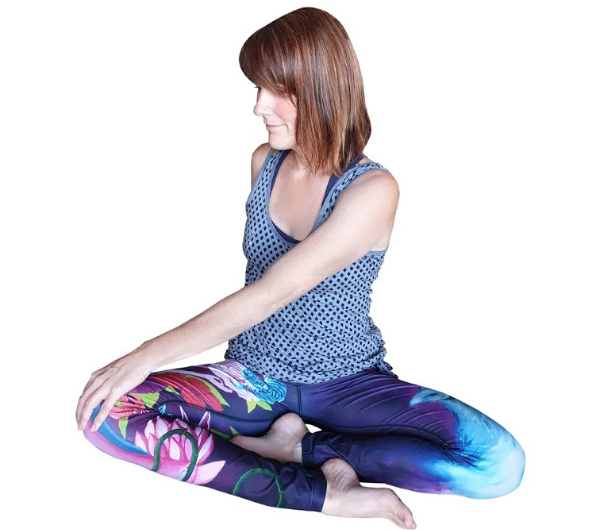
by Sonya Simpson,
Early in my yoga teaching career, I guided a group of five website developers in a corporate ‘one-off’ that a young, confident business owner from Sydney arranged. He called it a chance for his staff to do ‘something different’.
Within the practice I guided a tall lanky man with an awkward gait through a chilled, gentle practice. He was clearly uncomfortable on the yoga mat.
I got the impression that he felt anxious being with me, a stranger, in the small studio space. I tried being warm, humorous, simple… but nothing worked to calm him and by the time the hour was over he was drenched in sweat, and I swear it wasn’t the heat in the room or the pace of the class.
After sitting with him and the group for a while, he started to open up and he showed me the hypermobility of his joints. He could turn his leg so that his foot pointed straight out behind him and it seemed that every joint in his body had similarly exceptional ranges of movement. Yoga was new to him and he had no idea where his own body would go in the practice. He was used to sitting in a chair and keeping his body as still as possible because he couldn’t trust it not to do anything wild.
His proprioception – perception or awareness of the position and movement of the body – was completely out of kilter and his levels of anxiety were at towering heights.
I wanted so much to assist him in being present and comfortable in his skin. I never saw him again even though I practically begged him to continue exploring this method of connection.
Why is it so important to me? Because I’ve not only experienced first-hand the way that becoming present helps alleviate anxiety and depression, I’ve been told numerous times over the years from people who practice with me that it helps them. I’ve also seen the long descent down the rabbit hole that comes from losing connection to self. That to me is reason enough to champion the practice of proprioception.
Here are my tips for cultivating proprioception in your own yoga practice:
Start in restorative rest pose; lying on your back with your knees either bent or resting on a bolster, soles of your feet on the floor. Drop into your body, connect, feel the floor under your body – all the points of connection – and the weight of your body releasing down into the earth. Notice that you no longer need to hold yourself up, you can release and let go. Notice your breath. Sometimes it helps to have your hands resting on your belly, so you can be aware of their rise and fall. How are you feeling? Are there any sensations of pain or discomfort? How are your energy levels? Bring your soft awareness to your mind, how are your thoughts? Is your mind busy? Notice your thoughts without trying to change them and then slowly begin to move your soft focus back to your breath, the sensations in your body and your connection to the earth. With the information that you are receiving in this
Take
Move through a vinyasa of your choosing but in keeping with gentle kindness, so no pain. Try moving with your toes and fingers connected to the floor in any poses where you would normally lift them, as though you are making patterns in chalk on the ground. After you’ve moved for a while – say, the time it would take you to do three salutes to the sun – come down to child’s pose or a seated pose and centre again. Notice; is there any pain now? Discomfort? Tension? How is your energy? Your breath? Be aware.Continue to move through a flowing sequence at a different level than before, on hands and knees perhaps, or if you were at that level before then standing or lying down.
Be aware of the sensations that occur within your body. Move when you want to move, be still when you want to be still, flow like a dancer, or rest but always listen and respond. Become the curious child who hasn’t yet been told to be still and quiet, and then
Lie down and notice. How is your body now? Is there pain that wasn’t there before? Feel the way that your breath moves your belly up and down, the way your chest moves. Rest one hand on your belly just beneath your belly button, the other under your rib cage or perhaps on your sternum. Notice the way your breath moves your hands gently up and down and away from each other and then towards each other again.
Practice self-love. This is your body and you reside within it, be present and don’t try to make it do things that it’s not comfortable with. Come home and leave behind the
About Sonya

Sonya Simpson is a yoga teacher, content writer, business director and mother of two small boys. She lives with her partner in Auckland and teaches a style of yoga that is based around kindness to self, inquiry through movement and freedom to explore. Sonya is passionate about yoga and exploring the ways that cultural and societal expectation has affected wellbeing. Having experienced the benefits of returning to self through yoga during over 20 years of practice, she is passionate about continuing to research and explore how it can help others both inside and outside of the yoga community, sharing her findings wherever she can. More information can be found on her website, Facebook or Instagram.


Such an interesting read!
I suppose hypermobile people are working loads more than the rest of us to engage every muscle in their body to stabilize their joints in the poses.
I fully understand why yoga can be an overwhelming experience the first times people try it too. No wonder he felt the way he did even though you were doing everything you could to calm him.
My proprioception and body awareness in general has definitely improved so so much from doing yoga. It’s quite amazing how much yoga really can help us cultivate proprioception when done correctly. Thank you for sharing! 🙂